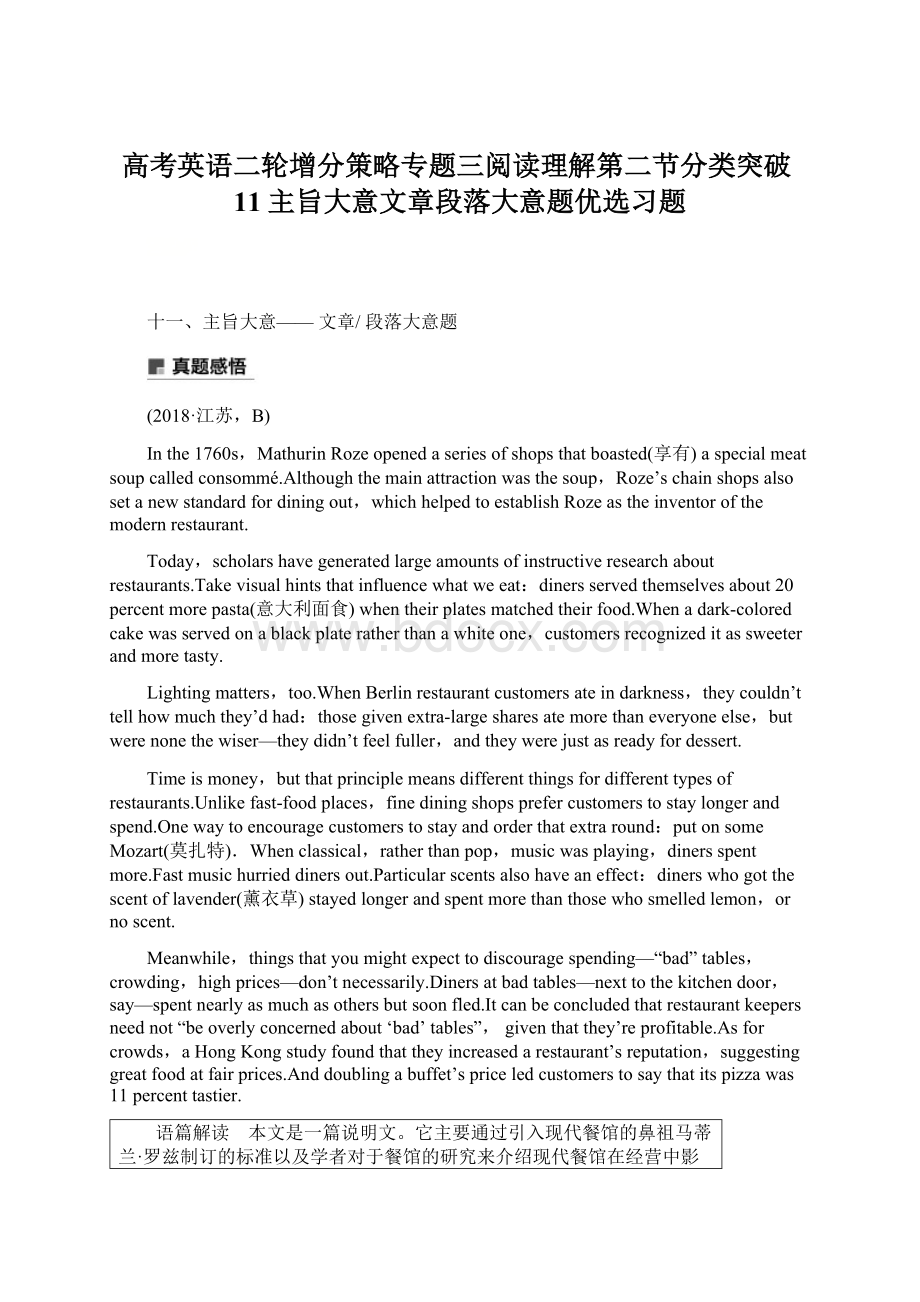高考英语二轮增分策略专题三阅读理解第二节分类突破11主旨大意文章段落大意题优选习题.docx
《高考英语二轮增分策略专题三阅读理解第二节分类突破11主旨大意文章段落大意题优选习题.docx》由会员分享,可在线阅读,更多相关《高考英语二轮增分策略专题三阅读理解第二节分类突破11主旨大意文章段落大意题优选习题.docx(21页珍藏版)》请在冰豆网上搜索。

高考英语二轮增分策略专题三阅读理解第二节分类突破11主旨大意文章段落大意题优选习题
十一、主旨大意——文章/段落大意题
(2018·江苏,B)
Inthe1760s,MathurinRozeopenedaseriesofshopsthatboasted(享有)aspecialmeatsoupcalledconsommé.Althoughthemainattractionwasthesoup,Roze’schainshopsalsosetanewstandardfordiningout,whichhelpedtoestablishRozeastheinventorofthemodernrestaurant.
Today,scholarshavegeneratedlargeamountsofinstructiveresearchaboutrestaurants.Takevisualhintsthatinfluencewhatweeat:
dinersservedthemselvesabout20percentmorepasta(意大利面食)whentheirplatesmatchedtheirfood.Whenadark-coloredcakewasservedonablackplateratherthanawhiteone,customersrecognizeditassweeterandmoretasty.
Lightingmatters,too.WhenBerlinrestaurantcustomersateindarkness,theycouldn’ttellhowmuchthey’dhad:
thosegivenextra-largesharesatemorethaneveryoneelse,butwerenonethewiser—theydidn’tfeelfuller,andtheywerejustasreadyfordessert.
Timeismoney,butthatprinciplemeansdifferentthingsfordifferenttypesofrestaurants.Unlikefast-foodplaces,finediningshopsprefercustomerstostaylongerandspend.Onewaytoencouragecustomerstostayandorderthatextraround:
putonsomeMozart(莫扎特).Whenclassical,ratherthanpop,musicwasplaying,dinersspentmore.Fastmusichurrieddinersout.Particularscentsalsohaveaneffect:
dinerswhogotthescentoflavender(薰衣草)stayedlongerandspentmorethanthosewhosmelledlemon,ornoscent.
Meanwhile,thingsthatyoumightexpecttodiscouragespending—“bad”tables,crowding,highprices—don’tnecessarily.Dinersatbadtables—nexttothekitchendoor,say—spentnearlyasmuchasothersbutsoonfled.Itcanbeconcludedthatrestaurantkeepersneednot“beoverlyconcernedabout‘bad’tables”,giventhatthey’reprofitable.Asforcrowds,aHongKongstudyfoundthattheyincreasedarestaurant’sreputation,suggestinggreatfoodatfairprices.Anddoublingabuffet’spriceledcustomerstosaythatitspizzawas11percenttastier.
语篇解读 本文是一篇说明文。
它主要通过引入现代餐馆的鼻祖马蒂兰·罗兹制订的标准以及学者对于餐馆的研究来介绍现代餐馆在经营中影响食客消费的几个要素:
视觉要素餐具、灯光、听觉要素音乐、嗅觉要素气味、其他要素桌位、拥挤程度和价格。
素材旨在通过现代餐馆的经营理念,让考生了解西方现代餐馆的经营之道。
58.Theunderlinedphrase“nonethewiser”inParagraph3mostprobablyimpliesthatthecustomerswere.
A.notawareofeatingmorethanusual
B.notwillingtosharefoodwithothers
C.notconsciousofthefoodquality
D.notfondofthefoodprovided
答案 A
解析 词义猜测题。
根据第三段中的“...thosegivenextra-largesharesatemorethaneveryoneelse,butwerenonethewiser—theydidn’tfeelfuller...”可知,那些被给以大份饭菜的食客比其他人吃得多,但他们没有饱腹感,这说明在黑暗的就餐环境下,食客并没有意识到自己比平时吃得多,所以nonethewiser意为“不清楚,不知道”。
故选A项。
59.Howcouldafinediningshopmakemoreprofit?
A.Playingclassicalmusic.
B.Introducinglemonscent.
C.Makingthelightbrighter.
D.Usingplatesoflargersize.
答案 A
解析 细节理解题。
根据第四段中的“Whenclassical,ratherthanpop,musicwasplaying,dinersspentmore.”可知,当演奏古典音乐而不是流行音乐的时候,食客们会花更多的钱。
spentmore就是对题干中makemoreprofit的语义转化。
故选A项。
60.Whatdoesthelastparagraphtalkabout?
A.Tipstoattractmorecustomers.
B.Problemsrestaurantsarefacedwith.
C.Waystoimproverestaurants’reputation.
D.Commonmisunderstandingsaboutrestaurants.
答案 D
解析 段落大意题。
根据最后一段首句“Meanwhile,thingsthatyoumightexpecttodiscouragespending—‘bad’tables,crowding,highprices—don’tnecessarily.”可知,你可能认为会打消你消费的念头的东西——位置“不好”的桌位、拥挤和价格高——未必如此(指在某些人看来,这些不利因素未必不会带来利润的增加)。
由此可知,作者认为这些对于餐馆的常见的观点是一种误解,故选D项。
一、文章大意题的题型解读
说明文、记叙文、议论文三种文体涉及的多种话题如社会文化类、人物故事类、科普说明类,多会考查文章大意类题。
设问形式常有:
(1)Whatisthemaintheme/topic/ideaofthispassage?
(2)Thepassageismainlyabout.
(3)Thegeneral/mainideaofthepassageis.
(4)Thepassagemainlyfocuseson.
二、文章大意题的解题技巧——“主题句定位”寻主旨
文章是由段落组成的。
段落的主题就是段落的中心思想,具体段落的中心思想又是为文章整体中心思想服务的。
理解整篇文章的中心思想的方法是建立在理解具体段落中心的基础上的。
找出每小段的主题句,各段的主题句常在该段的首句或尾句,各段主题句的整体归纳便是文章的中心思想。
有的文章无明显主题句,主题句隐含在段意之中,这就需要进一步加工概括。
观察全文的结构安排,理解文章的“重心”和支撑性细节。
主题句的位置一般有以下几种:
(1)主题句出现在文首。
开门见山,提出主题,用细节来解释或拓展主题句所表达的主题思想,是最常见的演绎法写作方式。
新闻报道、说明文或议论文通常采用这种写法。
(2)主题句出现在文末。
在表述细节后,归纳要点以概括主题,是最常见的归纳法写作方式。
(3)主题句首尾呼应。
为突出主题,作者先提出主题,结束时再次点出主题。
(4)主题句出现在中间。
写作方式为:
细节描述——归纳主题——进一步解释。
以下是找主题句的四个小窍门:
1.段落中出现表示转折的词语(如however,but,infact,actually等)时,该句很可能是主题句。
2.首段出现疑问句时,对该问题的回答很可能就是文章主旨。
3.作者有意识地重复的观点,通常是主旨;反复出现的词语,一般为体现文章主旨的关键词。
4.表示总结或结论的句子常包含therefore,thus,inshort,conclude,conclusion等词。
三、段落大意题的题型解读
段落大意类题型多在说明文和议论文中所涉及的各类话题如社会文化类、科普说明类等进行考查。
设问形式常有:
(1)Themainideaofthesecondparagraphprobablyis.
(2)Whatisthemainideaofthefirstparagraph?
(3)Thefirstparagraphismainlyabout.
四、段落大意题的解题技巧
(1)段首:
说明文和议论文中的主题句常在段首句
(2)段尾:
先表述细节,后归纳概括,段落中心在段尾
(3)段中间:
先用一句或几句话引出要表达的主题,再陈述主题,再论述细节,即引出主题→段落中心→再论述
(4)没有明显段落中心时,需概括段落内容,总结段落中心
例如:
真题感悟
中第60题,根据文章最后一段首句“Meanwhile,thingsthatyoumightexpecttodiscouragespending—‘bad’tables,crowding,highprices—don’tnecessarily.”可知,你可能认为会打消你消费的念头的东西——位置“不好”的桌位、拥挤和价格高——未必如此(指在某些人看来,这些不利因素未必不会带来利润的增加)。
由此可知,作者认为这些对于餐馆的常见的观点是一种误解,故选D项。
A
Mostofushavelostourwalletatsomestageinourlives.Butfewwouldimaginehavingitreturnedafteranearlyseven-decadegap.EdwardParkerdroppedhiswalletin1950intoaninaccessiblespotbehindabookshelf,whileworkingasanelectrician,repairingWorldWarTwobombdamageinthepalace.Thewalletstayedthereuntilthisyearwhenabuilder,doingsome1restorationwork,finallyfoundit.
Thewalletisatimecapsule.Itsleatherandwebbinghaslongagostartedtodisintegrate.Butitcontainsnumerouspicturesoffamily,invoices(发票),receipts,oldunioncards,resultsofachestX-ray(senttohimin1948,thesameyearastheNHSwasfounded),anationalservicecarddated9December1944andamedicalinsurancecard.Hisbusinesscards—EParker,ElectricalContractor—seemalmostoriginal.Reflectingthetypicalmethodsofcontactofthetime,theyhaveanaddressbutnotelephonenumber.
AmonthagoIwasspeakingtoa8pressofficeratLambethPalaceandhementionedthatthewallethadjustbeenhandedin.Wethoughtitmightbenicetotryandworkoutwhoseitwasandgiveitbacktothefamily.EdwardParkerisaprettycommonname,buthismedicalcardcontainedtwoplacesofresidence—PoetsRoadandSpringdaleRoadinnorthLondon.Fromthis,IslingtonCouncilwereabletofinddetailsofamarriagebetweenEdwardParkerandConstanceButlerin1947.
ThatinformationwasenoughtoworkoutthathewasstillaliveandinacarehomeinEssex,soIwenttovisithim.Now89,Edwardhasdementia(痴呆),buthewasclearlyhappytogetthewalletandinparticular,thephotographsback.Hepointedoutpicturesofhismotherandfather,hisbrother,hiscousinsandhiswifeConstance,whowaswithhimwhenIvisited.“Hehadn’tseenapictureofhisfathersincehelostthewallet,”Constance,90,says.
语篇解读 本文是一篇新闻报道,介绍了一个物归原主的故事。
爱德华·帕克曾是一名电工,他于1950年维修因二战受损的宫廷时,不慎将钱包丢失。
直到今年,钱包被一名宫廷修复工人发现。
钱包里的物品充满了那个年代的回忆,89岁的爱德华·帕克重新拿到钱包,非常开心。
1.WecanpossiblyinferthatEdwardParker.
A.onceworkedasanelectricaltechnician
B.alwayslosthiswallet
C.onceparticipatedinWorldWarⅡ
D.onceworkedasarestorationbuilder
答案 A
解析 推理判断题。
根据第一段第二句“EdwardParkerdroppedhiswalletin1950intoaninaccessiblespotbehindabookshelf,whileworkingasanelectrician,repairingWorldWarTwobombdamageinthepalace.”可知,EdwardParker曾是一名electrician(电工),因此A项正确。
2.What’sthemainideaofthesecondparagraph?
A.Thematerialofthewallet.
B.Theproducerofthewallet.
C.The9contentsofthewallet.
D.Theshapeofthewallet.
答案 C
解析 段落大意题。
本题适合用排除法。
A项钱包的材质;B项钱包的制造商;C项钱包里的东西;D项钱包的外形。
根据文章第二段,其中提到了钱包的外皮及边线已破损,钱包里有picturesoffamily(家人照片),invoices(发票),receipts(收据),oldunioncards(工会卡),resultsofachestX-ray(胸片报告),anationalservicecard(服务卡),amedicalinsurancecard(医保卡),businesscards(名片)等物品,可知A项表述片面,B、D项未提及,仅C项符合题意。
故选C。
3.Whatdoestheunderlinedword“disintegrate”inthesecondparagraphmean?
A.2Maintain.B.Damage.
C.Disappear.D.Destroy.
答案 B
解析 词义猜测题。
根据第二段第二句“Butitcontains...(但是,钱包里有……)”可知,钱包外皮还在,排除C、D项,A项“维护”,不符合文意;B项“损坏”,根据第二段前两句可知,“虽然钱包的外皮及边线已破损,但里面有……”,符合题意。
故选B。
4.Whatplaysakeyroleinreturningthewallettoitsowner?
A.Businesscard.B.Nationalservicecard.
C.Oldunioncard.D.Medicalcard.
答案 D
解析 推理判断题。
根据第三段第三句中的“buthismedicalcardcontainedtwoplacesofresidence”可知,他的医保卡上有两个住址,此处明确了医保卡是找到主人的关键物品。
故选D。
B
Inthird-worldcountriessuchasSwazilandandHaiti,a
15-dollarinventionismakingaworldofdifference.Nokero,acompanystartedbyBrianRants,sellslampsthatdonotrequirekerosene(煤油).Thesesolarlampshavebecomeastaple(主流产品)incountriesinAfrica,toprovidelightforreadingandsafetyatnight.
Nokerohassoldover500,000lampsinover120countriessinceitwasfirstfoundedin2010andRantsthinksthedemandforhisproductwillonlycontinuetoincrease.Mostlampsfoundinthird-worldcountries3currentlyrequirekerosenetorun,butkerosenecausesindoorpollutionandhasbeenlinkedtofiresthathavecausedoveramilliondeaths.
Insteadofexperiencingtheeffectsofsmoking40cigarettesadayfromkerosenelamps,Rantsthinkshissolarlampscouldbetheanswerforthird-worldcountries.TheEconomistagrees,callingsolarlights“thenextbig4innovationfortheworld’spoor”.Nokero’ssolarlampsarehigherinqualityandlessexpensivethanalotofsolartechnology,makingthemapractical6optionformanypeopleinthird-worldcountries.
Ratherthangivingsolarlampstoindividualsinneed,Nokero’s7missionistomakethem5affordable.ThroughresearchRantshasrealizedthatindividualswhobuyasolarproductwouldtakebettercareofitandvalueitmorethaniftheyreceiveditforfree.FamilieswhobuyNokero’ssolarlampsmakeupthecostinjustafewmonthsofnothavingtobuykeroseneorpayforoff-the-gridelectricity.
SomeactivistshaveattackedcompaniessuchasNokeroforsellingproductstothepoorratherthansimplygivingthem